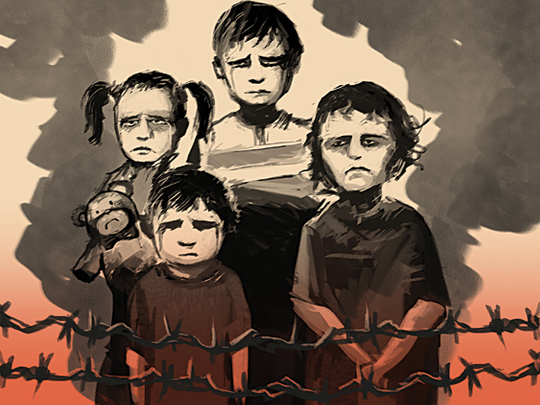
You learn a lot about people in war, in exile or both. A few days ago, I was mesmerised by a photograph of a row of five newborn babies in a United Nations-run medical facility in Gaza.
The babies, like infants everywhere, are swaddled in white, yellow, red and blue. Their tiny hands and feet poke out here and there and everywhere, harbingers of life and hope amid the destruction all around them.
Most Israelis are not seeing these pictures, I imagine, but they should — because these babies remind us of how men and women behave in exile, how nationhood happens, and how a people will pursue the end of their exile and refugeehood, however long that takes.
But back to the babies for a moment. Among this group of five newborns, the little guy on the right (I cannot tell their gender from the photo, so my imagination is at work here) lies on his back with his right foot raised higher in the air than the left; perhaps he is getting an early start on practicing soccer bicycle kicks.
Next to him is a very young lady in a fine yellow one-piece outfit decorated with cartoonlike drawings who reaches out with her hand to nudge the ear of the little guy to her left.
In the centre is another baby all dressed in white, with both feet up in the air as if trying to do crunches.
To his right is the giant of the group, a huge baby twice the size of the others, fully swaddled in a yellow and orange blanket and apparently sound asleep, probably from excessive milk consumption. At the left of the photo is the fifth baby, neatly dressed like the others and with her head turned to the others, perhaps trying to pick up some useful early-life tips.
The mothers stand or sit nearby, stroking their newborn children or simply gazing at them with the maternal laser love beams that are humankind’s most powerful form of affection and protection.
Terror amid tranquillity
And at the edges of the photo are two haunting young girls, one gazing ahead with her hand against her forehead, as if wondering when the ordeal of Gaza will end, because she is old enough, perhaps 7 or 8 years old, to have experienced several of its wars and many of its pains.
And from behind a standing adult UN health worker, a younger girl, perhaps 3 years old, peeks out onto the scene, as if scared to venture out into the daunting world. I also just read that 344 Palestinian babies were born in UN facilities during the past month of fighting.
Many others would have been born elsewhere in the Gaza Strip. More than 2,000 Palestinians died in the attacks on Gaza, but the hundreds born every month mean that the population keeps growing at a brisk rate.
Ever since the Babylonian exile of the Jews in the early sixth-century BC, exiled communities everywhere have expressed woe at their misfortune.
They beseech their deities and prophets for assistance and protection. Then, however, they go about the business of survival and maintaining their social rituals.
Finally, if they have the opportunity, they work to achieve their own repatriation. Exile breaks the links between a people and its ancestral land, and therefore it usually sharpens and deepens the national identity of the exiles themselves. But always during exile, life goes on, hope never dies, and many, many babies are born every year.
Israelis should ponder these issues because the Palestinian exile since 1948 has now lasted four years longer than the Jewish Babylonian exile (or 14 years longer, depending on when you believe the exile in Babylon started).
The 750,000 Palestinians who fled or were forcibly expelled from their homes in 1947-1948 during the creation of the state of Israel now number around 7 million. These babies represent the fourth generation in exile; like their predecessors, they will grow up seeking above all to end their refugeehood.
Jews should be the first people in the world to understand this yearning.
The Palestinians continue to live mostly within a few hundred miles of their ancestral homes, in refugee camps or integrated into Arab societies.
They fight and die when they feel that they must. But mostly they celebrate the joys of life as best they can.
They affirm again today — 344 times in Gaza alone last month — that there is no greater joy in life than new life itself.
— Washington Post
Rami G. Khouri is director of the Issam Fares Institute for Public Policy and International Affairs at the American University of Beirut.







